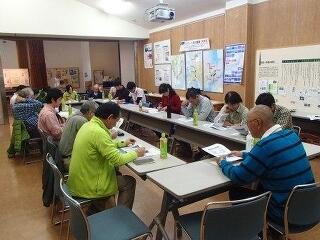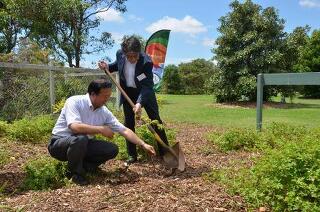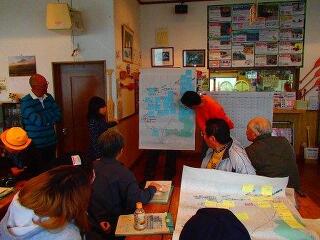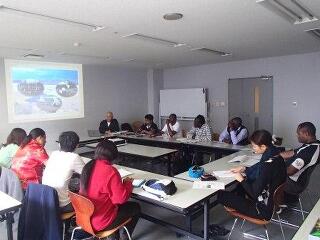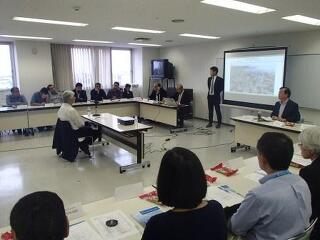Topics
-
2015-11-24
topics > No.27
KIWC Technical Committee On-site Study Meeting 2015
On October 15, 2015, the KIWC Technical Committee held an on-site study meeting to examine case examples under its 2013 – 2015 research theme of blessings of wetlands in communities. Committee members visited Hyotan Marsh, Lake Taro and Lake Jiro among Lake Akan’s neighboring lakes under the guidance of Dr. Isamu Wakana, a KIWC Technical Committee member and the curator of Kushiro City Board of Education’s Marimo Laboratory.
The first stop was the shallow eutrophic Hyotan Marsh, which has an average water depth of just 2 meters. Its increased summer phytoplankton growth causes water turbidity and a sparse population of underwater plants. Dr. Wakana’s commentary also covered the terrain upstream of the marsh.
The Committee members then moved on to the trailhead of Mt. Oakandake to visit Lake Taro and Lake Jiro. The water in the latter is clear because the yellow-brown lakebed mud is not agitated, making it visible from the surface, and has a blue hue when viewed from inside the lake. From Lake Jiro, the Committee members climbed almost vertically to an area with a cave from which cool wind blows. Ground temperatures in this area are under 1°C, indicating the presence of permafrost.
This cave area is home to flora from northern regions, whereas the area on the Mt. Hakuto side provides a habitat for plants from tropical and subtropical regions. The luxuriant growth of different types of flora in these areas despite their proximity demonstrates the Akan region’s high level of biodiversity. The area is also known for lakes and marshes that show the ecological succession of lakes. Its forest roads and mountain trails provide easy access to Lake Akan’s neighboring lakes, including Hyotan Marsh, Lake Taro and Lake Jiro. These characteristics make the region advantageous for research activities and as a place for learning.
Lake Akan is often associated with marimo algae balls and hot springs, but the area’s lakes are rich in other areas of diversity and potential. Possibilities for local research include: (1) genetic studies of fish and other organisms in Lake Akan, in neighboring lakes and elsewhere; (2) development of narratives based on traditional views of nature in the culture and history of Ainu people; and (3) efforts to strike a balance between environmental conservation and tourism promotion. The region is expected to continue yielding novel research findings that will highlight its uniqueness and significance. -
2015-11-16
topics > No.26
Sister-wetland Relationship Renewed
On November 6, 2015, the sister-wetland relationship between Kushiro wetlands (specifically Kushiro-shitsugen, Kiritappu-shitsugen, and Akkeshi-ko and Bekambeushi-shitsugen) and Hunter Estuary Wetlands was renewed in Australia. These wetlands originally established this relationship in 1994 to collaborate with each other on promoting the conservation and wise use of wetlands, and renewed the relationship in 2004.
KIWC President Hiroya Ebina (Mayor of Kushiro City) visited Newcastle, New South Wales, and signed a renewal agreement on the sister-wetland relationship along with Newcastle deputy mayor Michel Osborn and Port Stephens mayor Bruce MacKenzie, reaffirming the commitment to ongoing collaboration toward wetland conservation.
On the next day, Mr. Ebina visited an organization engaged in wetland restoration and planted a commemorative tree. -
2015-11-16
topics > No.25
Public Participation Survey of a Restored River Environment – Autumn 2015
On October 24, 2015, a public participation survey on a restored river environment was conducted in the Kushiro River section where the meander was restored to a natural stream section (approximately 5.5 kilometers from Kayanuma to Sugawara). Participants canoed down the river, observing riverbank vegetation, landscapes, animals, plants and other elements of the surrounding environment along the way. They stopped at two sandbanks to examine their size and geological formations. Sudden rainfall forced them to cancel some of the planned surveys and observations, and the participants worked together to paddle the canoes as fast and as hard as possible to their destination.
After completion of the survey, participants summarized their findings and results. Despite the difficulty of writing down their findings while canoeing down the river in bad weather, they shared a great deal of information, such as the discovery of a mink den and the difference in water color between the two streams at their confluence.
The survey, which has been conducted every summer and autumn since 2010, has revealed the effects and influences of the meander restoration. Now, local residents who are regular survey participants lead these surveys. For first-time participants, the survey provided a valuable opportunity to consider the conservation of Kushiro-shitsugen (Kushiro Wetland) from the perspective of a restored river.
The event was originally planned for September 13, but was postponed to October 24 due to inclement weather.
This initiative was implemented with river improvement funding provided by the River Foundation. -
2015-11-16
topics > No.24
KIWC hosts JICA Training Program on Eco-Tourism for Sustainable Use of Natural and Cultural Resources
From September 7 to October 12, 2015, KIWC ran a training program under commission from the JICA Hokkaido International Center (Obihiro). The aim of this training was to provide insight into eco-tourism programs involving local residents as a tool for the conservation and sustainable use of local natural and cultural resources. Ten government administrative officials and NGO staff members involved in tourism promotion and wildlife protection from nine countries attended this training program. Countries represented were Cambodia, Fiji, Gabon, Lesotho, Papua New Guinea, the Solomon Islands, Sri Lanka, Vietnam and Zimbabwe.
The trainees experienced eco-tours involving local residents that take local environments and wildlife into consideration at Lake Shikaribetsu, Shimizu Town and Kushiro wetlands (specifically Kiritappu-shitsugen, Akkeshi-ko and Bekambeushi-shitsugen and Kushiro-shitsugen). There, they witnessed examples of sightseeing tours operated by local residents that take advantage of local industries, such as agriculture, livestock farming and fisheries.
The trainees then traveled from Hokkaido to Tokyo, Chiba and Kyoto to attend programs allowing them to gain insight into the perspective of eco-tourism from certain aspects of Japanese history and culture, including Japanese traditional way of life, historic sites and satoyama (Japanese countryside landscape). They were also given presentations on eco-tourism theories and policies. Trainees also visited Okinawa, where they participated in sea kayaking and other programs to learn how local people utilize eco-tourism with their viewpoints and experiences.
The trainees expressed satisfaction with their experiences in Japan, describing Japan was a wonderful country and they had a valuable opportunity, before returning to their countries. -
2015-10-08
topics > No.23
KIWC hosts JICA Country-focused Training on the Anzali Wetland Ecological Management Project Phase II
As part of an ecological management project organized by the Japan International Cooperation Agency (JICA) for Iran’s Anzali Wetland, training was provided in various parts of Japan from August 31 to September 17, 2015. The course was attended by 12 administrative officials from Iran who are involved in wetland ecological management and basin control.
From September 7 to 11, the training was provided in the Kushiro region. The trainees were divided into two groups to visit the Kushiro Wetland and neighboring facilities. They learned about matters such as a nature restoration project being implemented for the wetland, canoe tour operation on the wetland, and treatment methods for waste and sewerage in the surrounding urban areas.
KIWC hosted a lecture and an inspection tour of the Kushiro Wetland on September 8 to highlight its history, conservation and wise use. While the attendees were at the Kushiro Marsh Observatory and the Onnenai Boardwalk as part of the tour, they were provided with commentary on the facilities’ roles in the wetland, operation and other matters, and proactively asked questions.
A discussion and exchange session was held on September 11 to round off the training in Kushiro with the attendance of KIWC staff, local residents and local government officials involved in the conservation of the wetland. The attendees engaged in lively discussions with the trainees. Finally, the KIWC Secretary General wrapped up the session with some general comments, highlighting hopes for the development of exchanges and collaboration among people involved in the conservation of the Kushiro Wetland and the Anzali Wetland in the future.
This training was run by Nippon Koei Co., Ltd. under commission from JICA.

